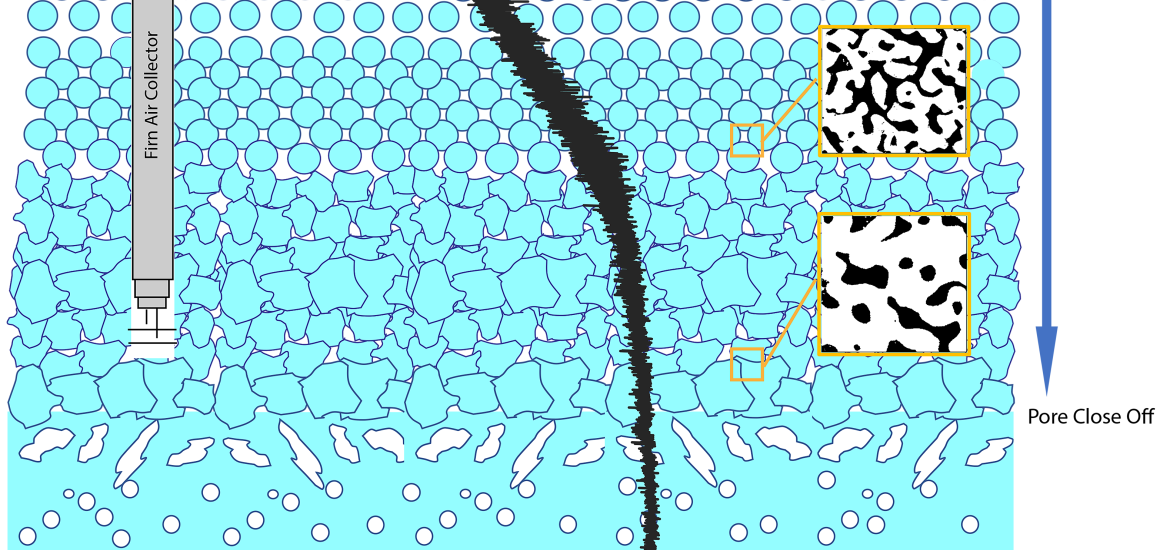- Home
- All News Overview
- Featured Article - Past Global Changes Magazine 30(2): Firn: Applications For The Interpretation of Ice-core Records and Estimation of Ice-sheet Mass Balance

Tuesday, 22 November, 2022
By: Drake McCrimmon, A. Ihle, K. Keegan and S. Rupper
Available in: Past Global Changes Magazine 30(2) 112-113 2022
> Access contents of this issue
> Download this article as pdf
Firn—old snow slowly densifying into glacial ice—provides valuable information for interpreting ice-core records, modeling meltwater runoff and sea-level rise, and improving our understanding of glacier dynamics through the interpretation of remote-sensing signals.
A glacier's cross section can be split into three main components: (1) a low-density layer of fresh snow at the surface, (2) a ~50–100-m-deep transition zone of densifying old snow called firn, and (3) hundreds to thousands of meters of high-density glacial ice at the bottom (Fig. 1). Firn is an important section of a glacier or ice sheet because the densification process and the grain structure impact how climate information is preserved by glacial ice. The microstructure of the firn (the size and shape of snow grains and pore space within the firn, Fig. 1c) influences both the movement and fate of air and water through the firn (Blackford 2007). These processes affect the interpretation of ice-core paleoclimate records, estimation of the capacity for firn to store glacier surface meltwater, and the use of remote sensing to study ice-sheet mass balance.
Interpretation of ice-core records
Gases trapped in ice cores generally reflect the atmosphere at a time in the past, thus allowing scientists to use ice-core gas records to reconstruct past atmospheric composition (Banerjee et al. p. 104), including greenhouse gases, extending back hundreds of thousands of years (Wendt et al. p. 102). The densification of firn is a major control on how gases are preserved in ice, so understanding this process is imperative for studying past climate.
Like surface snow, firn contains pore space between ice grains in which air can flow and liquid water can infiltrate. As firn density increases with burial depth, the space between snow grains shrinks until pores are closed off from one another (Fig. 1b, c). This depth, called the pore close-off depth, is the point when atmospheric gas becomes permanently trapped as bubbles enclosed in ice. Since gas is not trapped until the pore close-off depth, the air that is trapped in bubbles is younger than the surrounding ice (Schwander and Stauffer 1984). This difference in age is called Δage (delta age) and must be known to accurately date gas records from ice cores (Martin et al. p. 100). The Δage makes it possible to determine what the atmospheric composition was at specific points in Earth's climate history. Firn densification models, annual layer counting, and gas-diffusion models allow us to estimate Δage by determining the time it takes for firn to transition into glacial ice, as well as the time it takes for atmospheric gas to move through the firn to reach the pore close-off depth.
Figure 1: Background illustration shows the evolution of snow to firn to ice. (A) The firn-air collection apparatus. (B) Example density profile from snow surface through pore close-off to glacial ice (Burgener et al. 2013). (C) Example microCT images at differing densities, with black denoting pore space and white denoting ice grains.
Available in: Past Global Changes Magazine 30(2) 112-113 2022
> Access contents of this issue
> Download this article as pdf